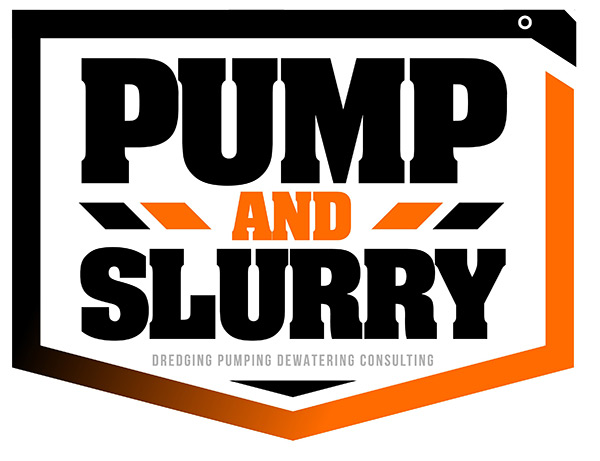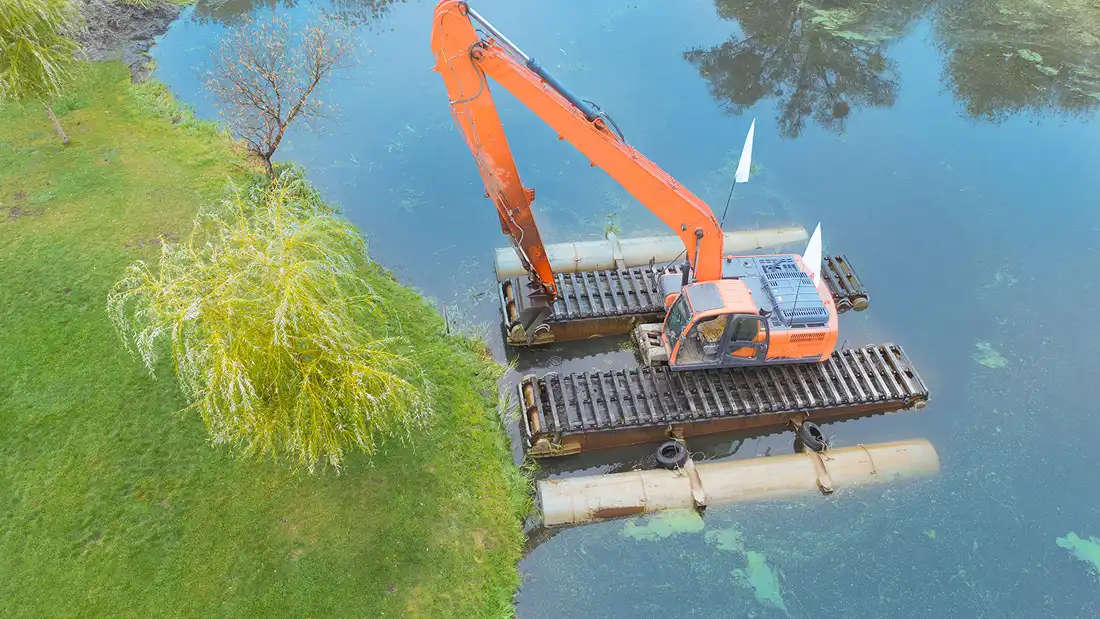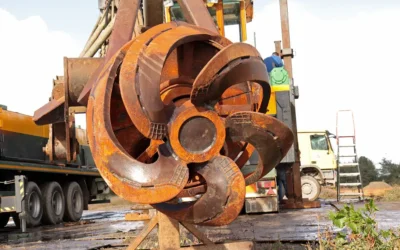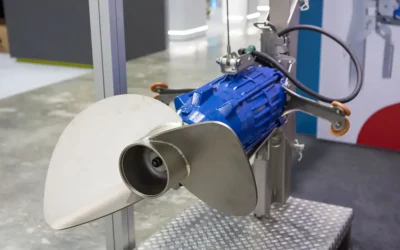Reservoir Dredging is a critical maintenance process that supports the long-term functionality of water infrastructure across municipal, industrial, and environmental sectors. Over time, all sorts of debris, sediment, organic material, you name it, build up in reservoirs and lagoons. This isn’t just a minor inconvenience. It chips away at capacity and hits operational efficiency right where it hurts. We’re talking real headaches for anyone relying on these systems: municipalities managing water supply, site managers handling flood risks, or industrial players needing reliable water treatment.
For procurement teams, engineering managers, or contractors, it’s a balancing act. You can’t ignore the buildup. But tackling it the old-fashioned way? That means high costs, increased downtime, and navigating complex regulatory requirements. Let’s be honest, not exactly what anyone wants to sign up for.
That’s why the industry’s on the lookout for smarter solutions. There is now an appetite for methods that deliver results faster, cut expenses, and actually make compliance easier, not harder. With new technology and improved processes, we’re seeing more streamlined sediment management. Project timelines become shorter, returns improve, and staying within regulations is significantly less painful. In short, innovation’s finally catching up to the scale of the problem, and it’s changing the way we do business.
In this article, we examine the latest innovations in dredging techniques, ranging from high-performance suction and mechanical systems to environmentally friendly methods designed for water management and lagoon maintenance projects. By emphasizing real-world applications and quantitative outcomes, we aim to guide decision-makers toward more effective and sustainable policies.
Modern Reservoir Dredging Techniques That Save Time and Cost
The progress of reservoir dredging has led to the development of several innovative procedures that significantly reduce operational time, environmental impact, and overall project costs. The suitable approach is determined by parameters such as sediment type, water body size, accessibility, and environmental sensitivity, making the right option critical for effective water reservoir dredging and dredging operations.
Hydraulic Dredging
Hydraulic dredging remains one of the most used technologies for large-scale reservoir dredging operations. This approach, which utilizes strong pumps to transport silt as a slurry through pipes, enables continuous removal with minimal mechanical damage. Cutter suction dredgers are particularly useful for deeper basins or reservoirs with compacted beds. In contrast, auger suction systems are favored for the fine silt and organic muck found in water reservoir dredging. These methods are perfect for large-scale removal with limited shoreline access, eliminating the need for staging locations and heavy equipment on land.
Mechanical Dredging
Mechanical dredging involves the use of machinery, such as clamshell buckets, excavators, and backhoes, to scoop and remove dirt. This strategy is especially useful in urban or industrial settings when access is limited and waste or thick materials are present. While mechanical dredging is often slower than hydraulic dredging, it provides more control in limited locations, making it ideal for focused lagoon dredging operations or silt removal near infrastructure.
Precision and Eco-Friendly Dredging Technologies
Advanced positioning systems such as GPS, LiDAR, and sonar mapping now enable highly targeted dredging operations. These technologies help minimize over-dredging, reduce disturbance to aquatic ecosystems, and ensure compliance with environmental regulations. Remote-controlled and automated dredging platforms further enhance precision, especially useful in restricted or hazardous areas.
Jet-Lift and Airlift Dredging
Jet-lift and airlift methods use water or compressed air to move lighter sediments vertically through narrow tubes. These low-impact techniques are ideal for smaller reservoirs, lagoons, or locations with fragile ecosystems. They are especially useful where traditional suction or mechanical systems are impractical due to space, depth, or regulatory constraints.
Amphibious Dredging
Designed for versatility, amphibious dredgers can operate both in water and on soft terrain, enabling seamless transitions across tidal zones or flooded areas. These machines are highly effective in shallow or seasonally fluctuating environments, allowing continuous dredging without the need for expensive marine infrastructure.
By integrating these modern techniques into their reservoir dredging strategies, project owners can significantly reduce fuel consumption, labor costs, and downtime. Whether addressing large-scale water reservoir dredging or highly localized lagoon dredging, the selection of the right equipment and method directly influences both short-term efficiency and long-term cost control.
Innovative Alternatives to Traditional Reservoir Dredging
While conventional reservoir dredging methods remain effective for large-scale sediment removal, many public and private sector projects are now turning to alternative solutions that offer lower costs, reduced environmental impact, and simplified logistics. These modern alternatives are especially valuable for smaller-scale water reservoir dredging and dredging applications where full-scale dredging operations may be impractical or unnecessary.
Hydro-Raking
Hydro-raking is a mechanical method for removing vegetation and sediment from shallow water bodies, utilizing a floating backhoe to extract organic matter, aquatic plants, and fine sediments. Unlike traditional reservoir dredging, hydro-raking does not require extensive shoreline staging or the mobilization of complex equipment. This makes it ideal for stormwater ponds, urban lagoons, and smaller reservoirs where environmental sensitivity and access limitations are key concerns. It’s a cost-effective and eco-friendly solution that minimizes shoreline disruption while extending the life of the reservoir.
Biological Dredging and Nanobubble Aeration
Biological dredging introduces natural microorganisms and oxygenation processes into the water body to accelerate the decomposition of organic sludge. Techniques such as nanobubble aeration increase dissolved oxygen levels, creating conditions that enhance microbial activity and promote the natural breakdown of sediment layers. These systems are particularly well-suited for lagoon dredging and smaller-scale water reservoir dredging projects where the sediment load consists primarily of organic material.
Though not a complete replacement for mechanical or hydraulic reservoir dredging, biological methods offer a sustainable approach to maintenance and can delay the need for more invasive interventions. They are also beneficial in sensitive ecosystems where physical dredging could cause ecological disturbance.
Sediment Control and Prevention Strategies
In many cases, the most cost-effective reservoir dredging strategy is to reduce future sediment accumulation. Techniques such as installing silt curtains, sediment traps, and vegetative buffers can dramatically slow the rate of sedimentation in reservoirs and lagoons. These sediment management practices are increasingly being used in conjunction with both traditional and alternative dredging methods to maximize long-term effectiveness and reduce the frequency of major dredging cycles.
By implementing these innovative alternatives to conventional reservoir dredging, asset managers and project engineers can reduce capital expenditure, minimize operational disruption, and enhance the sustainability of their water infrastructure. Whether supporting water reservoir dredging for municipal supply or lagoon dredging in industrial facilities, these approaches provide flexible, scalable solutions that align with both budget and environmental goals.
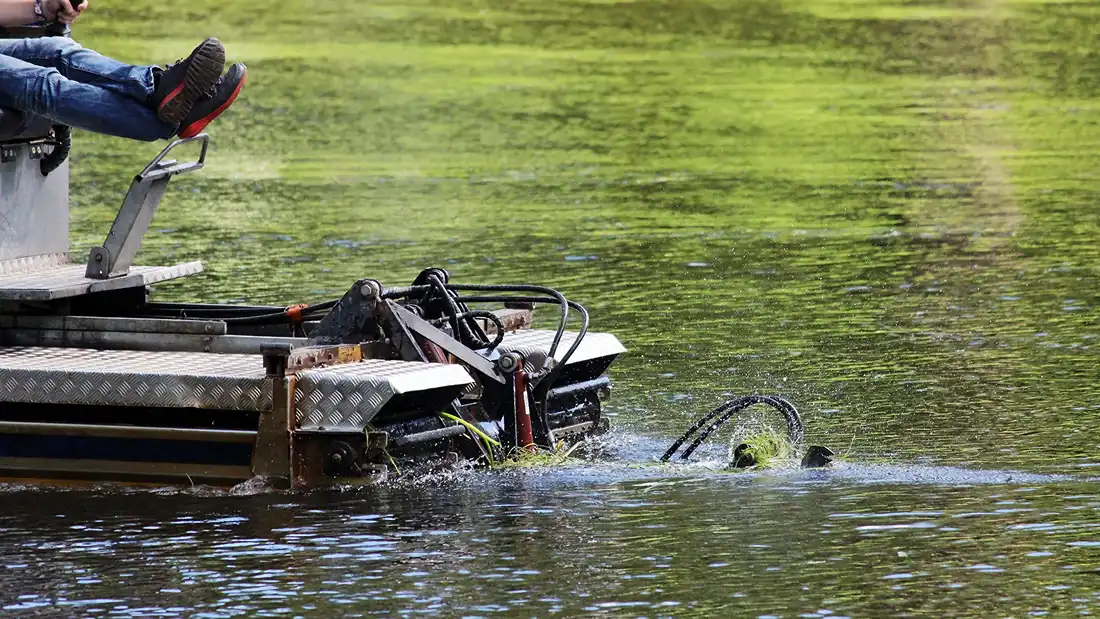
Why Reservoir Dredging Is Expensive, And How to Reduce the Cost
Dredging plays a vital role in maintaining water infrastructure, but it is also one of the most resource-heavy operations undertaken by municipal authorities, industrial facilities, and project contractors. Whether the task involves cleaning for drinking water systems or lagoon maintenance for wastewater and industrial runoff, understanding the main cost drivers behind these projects is crucial for budgeting, procurement, and long-term planning.
Major Cost Drivers in Dredging
- Equipment Mobilization
Transporting dredging equipment to remote sites often requires specialized vehicles, careful logistical coordination, and permits. Machines such as cutter suction dredgers, amphibious units, and support barges are not only costly to operate but also expensive to transport, especially in inland or high-altitude locations where access by road or rail is limited. - Fuel and Skilled Labor
Dredging operations depend on high-powered pumps and machinery, which consume large amounts of fuel. Additionally, experienced operators, technicians, and safety personnel are required, which increases labor costs. Together, fuel and labor form a significant portion of project budgets. - Maintenance and Equipment Wear
Dredging equipment works in tough, abrasive environments. Constant exposure to silt, rocks, and debris accelerates wear on pumps, pipes, impellers, and cutting components. Regular maintenance and replacement of parts are essential, particularly for long-term projects or those involving dense sediment layers. - Permitting, Engineering, and Compliance
Before starting, project owners must conduct engineering surveys, secure environmental permits, and complete impact assessments. Compliance with environmental regulations often involves detailed documentation and coordination with various agencies, particularly when working in ecologically sensitive areas or near municipal water sources. - Material Disposal
Handling and disposing of dredged material, especially when it is contaminated, can significantly increase costs. Disposal methods vary from landfill transport to on-site dewatering and reuse, depending on sediment composition and regulatory demands. Local restrictions in populated areas can add time and complexity to the process. - Site-Specific Factors
Every dredging project is unique. Factors like depth, sediment type, access, water flow, and downstream effects all influence the scale and method required. Operations in confined industrial lagoons present different challenges and expenses compared to those in large dams or flood control basins.
Reducing the Cost of Dredging
Modern dredging techniques prioritize efficiency and precision to minimize overall expenses. Using modular, portable equipment reduces mobilization time and transportation costs. GPS-guided systems and sonar mapping reduce unnecessary excavation, minimizing fuel use and improving accuracy. Additionally, integrating alternative methods, such as biological treatment or sediment control structures, can delay the need for full-scale cleaning or sediment removal.
By knowing these cost elements and choosing the best method, stakeholders can substantially boost their return on investment. Whether for military lagoon projects or municipal water infrastructure, effective planning requires the correct mix of technology, logistics, and strategy.
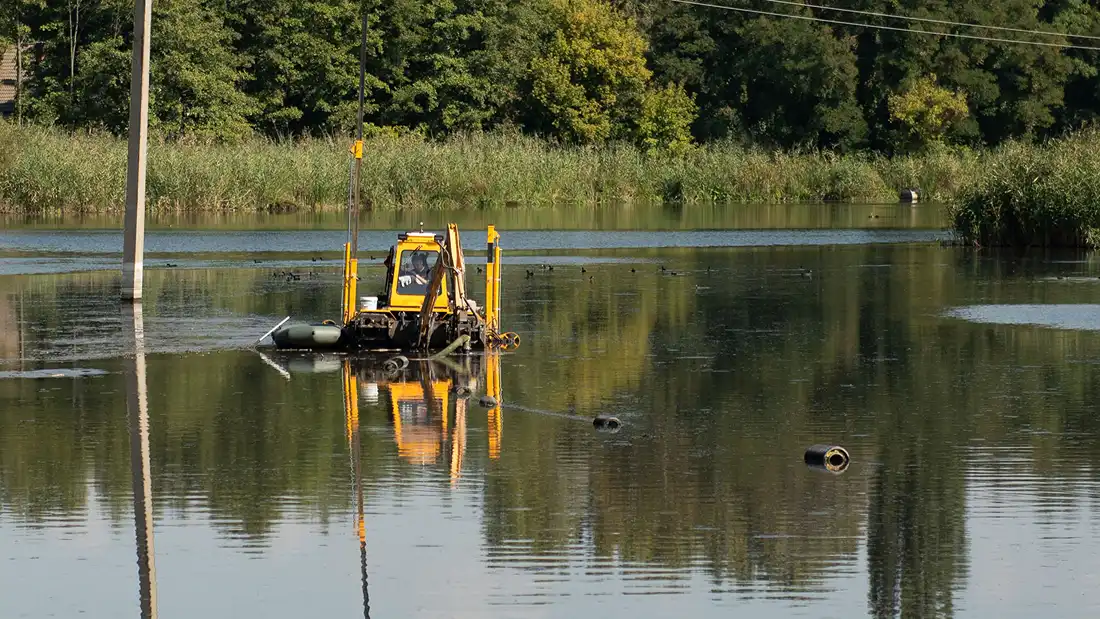
Understanding the Cost of Reservoir Dredging in India
Reservoir dredging in India plays a crucial role in supporting agricultural irrigation, drinking water supply, flood control, and industrial operations. However, dredging costs can vary dramatically based on project scale, regional logistics, sediment characteristics, and regulatory requirements. Whether the project involves water reservoir dredging in rural areas or lagoon dredging in industrial zones, understanding local cost dynamics is key to effective planning and procurement.
Typical Pricing for Reservoir Dredging Projects
In India, small-scale water reservoir dredging, such as desilting of ponds, tanks, and community reservoirs, typically costs between ₹250 and ₹500 per cubic meter. These projects often involve basic suction dredging equipment and limited sediment transport requirements, making them more cost-effective, particularly in accessible areas.
For larger reservoir dredging projects, such as those involving major irrigation dams, drinking water reservoirs, or inland waterways, costs can be significantly higher. Deep dredging, handling contaminated sediment, and remote site mobilization contribute to increased expenses. Projects requiring specialized hydraulic dredgers, GPS-guided precision systems, or amphibious access often exceed ₹1,000 per cubic meter, especially when combined with environmental compliance and long-distance material transport.
Lagoon Dredging and Industrial Applications
In India, where it is commonly required for wastewater treatment plants, chemical industries, and power generation facilities, it presents its own cost structure. These sites often involve constrained space, hazardous sediments, and strict environmental regulations. As a result, lagoon dredging projects demand specialized equipment and careful waste handling procedures, often placing them at the higher end of the cost spectrum.
Market Trends and Procurement Considerations
The Indian reservoir dredging market is currently experiencing two notable trends:
- Competitive Pricing Among Large Contractors:
With increasing demand from government infrastructure programs, international and domestic dredging companies are actively competing for large-scale water reservoir dredging contracts. This has led to more competitive pricing in major tenders, particularly where long-term service contracts are offered. - Localized Solutions for Small and Medium Projects:
Domestic contractors are focusing on cost-effective dredging solutions for rural and semi-urban water bodies. These include modular dredging units for small reservoirs and mobile setups for lagoon dredging, helping reduce mobilization and labor costs while maintaining operational efficiency.
For government agencies, EPC contractors, and private sector buyers, selecting the right dredging approach —whether full-scale reservoir dredging or targeted lagoon dredging —requires a careful balance of budget, project scope, environmental considerations, and execution timelines.
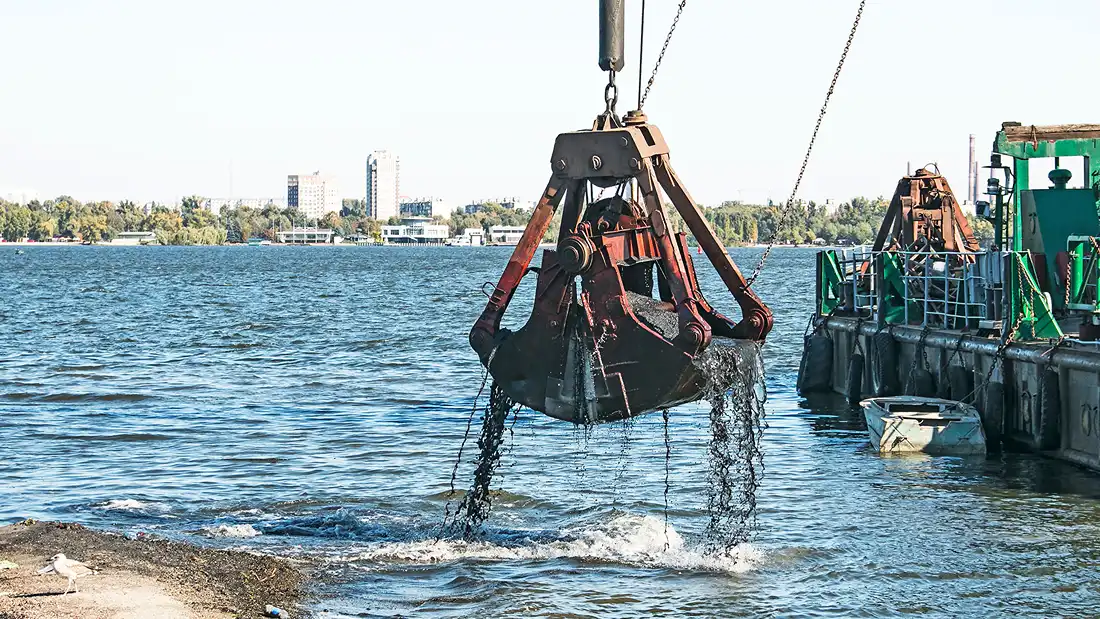
Real-World Applications of Reservoir Dredging Across Industries
Reservoir dredging is not a one-size-fits-all operation. Its real-world applications span a wide range of industries, from public infrastructure and environmental restoration to industrial processing and defense. By selecting the right reservoir dredging method, organizations can significantly reduce operational disruptions, enhance water quality, and extend the usable lifespan of critical water assets.
Municipal Water Reservoir Dredging Projects
Cities and municipalities across India and globally rely on a consistent water supply from storage reservoirs. Over time, siltation reduces water-holding capacity and affects distribution pressure and treatment efficiency. In one recent case, a mid-sized city in southern India deployed auger suction dredging to restore capacity in a primary drinking water reservoir. The use of precision dredging enabled the project to be completed without disrupting nearby communities or existing pumping infrastructure, demonstrating how modern water reservoir dredging techniques enhance reliability while minimizing service downtime.
Industrial Lagoon Dredging for Wastewater Management
In the industrial sector, lagoon dredging is essential for maintaining the function of wastewater treatment ponds and sedimentation basins. For instance, a metal processing facility in western India used mechanical dredging to remove accumulated heavy-metal sludge from a lined lagoon. Remote-operated dredgers were used to minimize personnel exposure and environmental impact. The operation restored compliance with pollution control norms and avoided costly shutdowns, highlighting the role of targeted lagoon dredging in maintaining regulatory and operational performance.
Military and Defense Infrastructure
Reservoir dredging also supports military readiness. Defense installations with standalone water storage systems, including naval bases and army depots, often require periodic water reservoir dredging to ensure an uninterrupted supply for drinking, sanitation, and cooling operations. Amphibious dredging platforms are increasingly used in these environments to access shallow, tidal, or restricted areas without the need for permanent access roads. These platforms support rapid deployment, precision dredging, and minimal ecological disruption, ideal for high-security, mission-critical installations.
Mining and Energy Sector Applications
In mining, reservoir dredging is used to manage tailings ponds and water recycling basins. A recent project in central India involved hydraulic dredging of a coal ash lagoon at a thermal power plant. The operation utilized high-capacity slurry pumps and on-site dewatering units to recover water for reuse, thereby significantly reducing the plant’s freshwater demand. Such lagoon dredging efforts demonstrate how modern dredging can enhance resource efficiency and promote environmental compliance in the heavy industry sector.
Environmental and Ecological Restoration
Reservoir dredging is also a key strategy in environmental rehabilitation projects, particularly where sedimentation poses a threat to biodiversity or the function of wetlands. In a government-led initiative, lagoon dredging was used to restore a degraded wetland in an urban watershed. By removing nutrient-rich sediment, the project helped reduce algal blooms and improve overall water quality, creating measurable ecological and community benefits.
Across sectors, these examples demonstrate that when reservoir dredging is executed with the right technologies and techniques, whether in large-scale water reservoir dredging or targeted lagoon dredging, projects can achieve greater efficiency, compliance, and return on investment.
Choosing the Right Reservoir Dredging Strategy for Maximum ROI
With rising demands on water infrastructure and tightening environmental regulations, choosing the right reservoir dredging strategy is more critical than ever. Whether managing large-scale water reservoir dredging for municipal supply or targeted lagoon dredging for industrial wastewater, project success depends on aligning the method with site conditions, operational goals, and budget constraints.
Matching the Method to the Application
Not all sediment removal methods deliver the same performance or return on investment. For large water bodies with soft, fine sediments, hydraulic dredging offers fast, continuous operation and minimal surface disruption. For areas containing heavy debris, gravel, or compacted silt, mechanical excavation may provide a more precise method of sediment removal. In shallow or ecologically sensitive zones, amphibious dredging or airlift systems can reduce environmental impact and improve site access, especially beneficial in lagoon projects near protected areas or critical infrastructure.
When operators adjust their strategies to fit both the site’s physical characteristics and applicable regulations, they can avoid unnecessary expenses, reduce operational delays, and enhance the overall efficiency of sediment removal activities. Tailoring approaches in this way directly supports more effective project outcomes.
The Role of Preventive Measures and Hybrid Solutions
Periodic sediment removal is still necessary; there’s no way around it. Yet, a growing number of institutions are leaning into proactive management methods to cut down on how often they need those big, disruptive cleanouts. For example, they’re putting up silt curtains (which act as underwater barriers), installing sediment traps upstream, and creating vegetative shoreline buffers, all of which help slow down the rate of sediment accumulation.
In smaller settings, like lagoons or modestly-sized water bodies, it’s not just about the physical barriers. There’s an uptick in the use of biological techniques and advanced technologies, such as nanobubble aeration, to enhance water quality and keep organic sediment from building up too quickly. When you blend these preventative strategies with the standard, large-scale sediment removal, you get a more balanced approach that can actually stretch the lifespan of the infrastructure, lower overall lifetime costs, and minimize the environmental impact of maintenance.
Strategic Planning and Long-Term Gains
Effective sediment management extends far beyond the mere selection of equipment—it requires a multi-faceted approach grounded in rigorous planning and technical analysis. This includes thorough site evaluation, careful sediment characterization, logistical coordination, regulatory permitting, and, crucially, deliberate post-removal maintenance procedures. Early involvement of specialized sediment management professionals is essential, as it enables stakeholders to rigorously assess traditional practices, novel technologies, or hybrid solutions that best align with organizational objectives and budgetary constraints.
For procurement specialists, engineering leads, or municipal planners, a nuanced comprehension of the complete array of sediment removal and lagoon maintenance methodologies is absolutely fundamental for sound, cost-effective decision-making. When these interventions are thoughtfully implemented, the benefits extend far beyond immediate restoration, encompassing increased operational efficiency, enhanced compliance with environmental standards, and the prolonged lifespan of critical infrastructure assets.
Conclusion: Smarter Reservoir Dredging for Sustainable Performance and Cost Efficiency
As demand for dependable water infrastructure, industrial uptime, and environmental compliance rises, sediment removal has become a strategic need in both the public and private sectors. From large-scale dredging in municipal and agricultural systems to precise lagoon management for industrial and military sites, today’s projects require more than simply sediment removal; they also require efficiency, accuracy, and long-term value.
Modern sediment management is no longer constrained by old, one-size-fits-all approaches. GPS-guided equipment, amphibious platforms, and remote-operated systems are examples of technological advancements that give accurate and efficient solutions adapted to specific site circumstances. At the same time, hybrid techniques that include sediment removal, control measures, and biological treatments assist organizations in lowering long-term expenses while maintaining adjacent ecosystems.
Success for decision-makers in charge of reservoir dredging or lagoon projects depends on strategic planning and the selection of the most effective procedures. Choosing procedures depending on sediment type, site access, regulatory limitations, and project scale has a direct impact on both immediate expenses and long-term ROI.
At Pump & Slurry, we specialize in providing performance-driven sediment management solutions that are tailored to each client’s operational and environmental requirements. Our knowledge extends to municipal, military, industrial, and environmental applications, assuring the correct technology, approach, and demonstrable outcomes.
Contact Pump & Slurry today to discuss your sediment removal needs and discover customized solutions that optimize efficiency, reduce costs, and maximize ROI.




